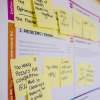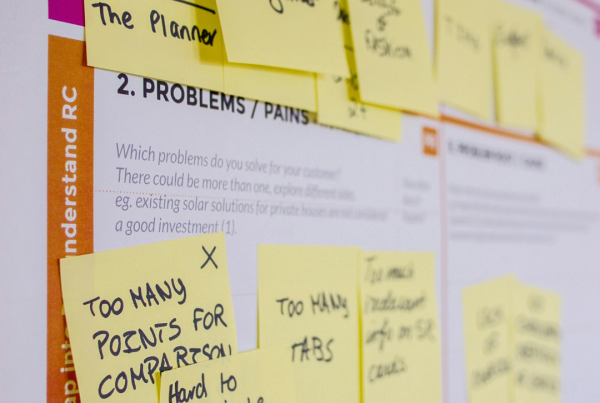As the founder of a design agency, people often ask me for advice on design or building and running a business. While I love to share my painful lessons and sweet victories, after a while it sounds stale coming out of my mouth. This gave me inspiration on my next project — writing about how I built my design agency, Relab.
I’ve tried to break down the process into easy-to-follow steps, which anyone can take, provided you are willing to work hard for years to come. These steps, hopefully, will help you build your own small business that’s profitable enough to change your life as it did mine. As the steps are too big to be written in one post, I will break it up into 6 parts over 6 months. This first post is about how I got all my ducks in a row to officially start building my design agency. Before we proceed, I have a few disclaimers.
My disclaimers:
- I started freelancing during my university days, and I believe most people did. Therefore, you can say that I’ve been “building” a design agency from then. But for the sake of simplicity, I will start from when I started to eat, breathe and sleep my baby — Relab.
- I’d like to emphasise that this was how I built Relab. You may end up taking a different route, but I believe the principles are the same. It all boils down to you — 95% of it. The rest is luck.
- I’ve used $3000 as a base capital to buy your tools. Technically, all you need is a laptop, software, and an internet connection. If you already have this covered, then the only capital needed is about $0. Fire away!
Step 1: Figure out your why
I need to get this out of the way first, because building your own business is never going to be a straight road. You will be tested time and time again, so you need to be in it for the long haul.
I’ve always wanted to be my own boss from my teenage years. Back then, I’d picture myself running a small bespoke agency with 4–5 employees in a hipster area. Thankfully, Relab has grown to be bigger than my dream.
The point is, you should always have a big picture view because it gives you a stronger sense of purpose, especially when your chips are down. Personally, I believe people can only go as far as their own desires. Whether you desire to be a full-time freelancer or a CEO of a multinational company, your outcome will turn out exactly or close enough to what you wanted in the first place.
Step 2: Build your piggy bank
I worked full-time for 4 years before taking the leap to part-time. It wasn’t merely to save money but also to gain experience. If you’re fresh out of school, trust me, you have a lot to learn. You may be a savant designer, but you still need to learn how to collaborate, fight for your ideas, and work with and manage people.
In terms of lifestyle, try to be frugal. Depending on your salary, save 10% — 30% into a fund dedicated to your dream. Within several months, you should have $2000, which I think is the first checkpoint for a personal security deposit. Remember, whatever you do, don’t ever touch it. I touched mine a few times and regretted it.
I should add that I wasn’t married yet or had kids at this point, so saving a big part of my salary was easy. If you’re with family, your piggy bank will have to be bigger and your patience stronger.
Step 3: Find a part-time gig
Once you’re confident of your savings and in the amount of side work you have, it’s time to take the leap into a part-time job.
What’s this, you say? You still have to work under someone?
Unfortunately, yes.
Look, you can be gung-ho and throw it all on the line, except you must face the fact that you need money for rent, food, bills and stuff. Unless you have rich parents or can live without food and water, then I’d suggest you find a steady stream of income.
Working part-time allows you to earn money while still have time to find clients, work on projects and build your design agency. If you work as a part-time designer, doing 3 to 4 days a week, you can potentially earn $2000 — $3000 per month.
However, you don’t need to work as a designer, as long as you get paid enough to sustain a frugal lifestyle.
In fact, I would argue that it’s better to work in something that’s unrelated, such as in retail and hospitality, or somewhat related to design. Try going for work that teaches you valuable skills to run a business and manage clients because you will need it in spades when running your own agency.
I worked part-time as a marketing coordinator in a non-profit organisation. I loved my time there and I sure as hell learnt a lot from it. The best thing was that after 8 hours of marketing work, I was pumped to go home and work on design projects for my clients. It kept my days fresh and exciting.
Of course, you can look at other income avenues. You could be a YouTube star or make money from forex trading, what matters most is a stable income going into your bank account every month for you to survive.
”Try going for work that teaches you valuable skills to run a business and manage clients because you will need it in spades when running your own agency.
I worked part-time as a marketing coordinator in a non-profit organisation. I loved my time there and I sure as hell learnt a lot from it. The best thing was that after 8 hours of marketing work, I was pumped to go home and work on design projects for my clients. It kept my days fresh and exciting.
Of course, you can look at other income avenues. You could be a YouTube star or make money from forex trading, what matters most is a stable income going into your bank account every month for you to survive.
Step 4: Buy your tools
It’s time to talk finance. You can skip this step if you already possess the basic tools a designer needs. But do remember to factor this cost into your business accounts.
Let’s say you don’t own a computer, then this would be the first investment to make in your business. You can use the piggy bank in step 2, but leave an emergency stash of at least $2000 for your business because unexpected expenses will crop up here and there.
For Mac users, I suggest buying an Apple’s certified refurbished laptop to save money. It’s cheaper, like new and is less risky than getting a second-hand off eBay.
And yes, you heard me, get a laptop.
A 13-inch MacBook Pro to be exact. Just pick one with a good working spec. As I’m writing this, the price for a decent graphic-design-friendly MacBook Pro is around $2000.
As a startup design studio, you must be flexible because you’ll be in meetings, cafes, clients’ offices, or working at home on the couch. You’ll be working so much that you’ll need your machine attached to you, and that’s where a laptop is handy. When you earn a little bit more money, buy yourself a good and large monitor worth around $600 — $800.
You’ll also need to acquire an individual license for Adobe that’s paid yearly. Apart from that, do not get fancy and splurge on a rented office or a hot desk. Just work from home or in public places.
Your design agency’s capital:
Refurbished MacBook Pro: $2000
Annual individual license for Adobe: $900
Emergency cash (nice to have): $2000
Total: $4900
Step 5: Hustle, hustle, hustle
Keep hustling outside of your part-time job to build your design agency. Don’t be too precious about the type of clients you take on and other ideals. The ideal job or client won’t fall from the sky, but that day will come if you stay consistent, I promise you.
Another tip I’d give is to be transparent from day one. Come clean with your boss and tell him or her that you’re building a business on the side. They’ll respect you for this.
In my case, I gained a lot from it because the non-profit I was working for ended up being the first retainer customer for Relab. That was around $3300 per month of consistent revenue, which helped tremendously. I’d also argue that finding regular clients are better than one-off clients in the early days of getting your business off the ground.
That’s it for the first blog post. Congratulations, you’ve taken the first leap into the unknown, going into a part-time job while building your agency. Until the next post, which is how to build an impressive portfolio, stay focused, continue what you’re doing and remember to keep saving your money.
Illustrations by: Irenne Tj
https://www.instagram.com/irennetj/
https://www.facebook.com/inspirationneverends/







